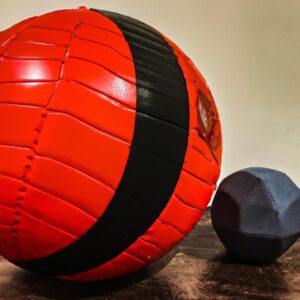Start Your Custom Workout Routine: Here’s How & Why

Introduction to Creating an Effective Workout Routine
It’s easy to get overwhelmed when deciding on how to approach fitness. With all the information out there, it can be difficult to know where to start. However, creating an effective workout routine doesn’t have to feel like a daunting task. With the right guidance and perseverance, you can create a custom program that works specifically for you and your lifestyle.
A personalized workout plan comes with plenty of benefits. Working out regularly can improve your mental wellbeing, reduce stress, increase energy levels, boost your mood, and help you reach your fitness goals. Whether you want to get stronger, lose weight, or just stay active, establishing an effective routine is key.
By following this guide, you’ll learn how to craft an effective workout plan that fits your needs. We’ll discuss assembling a toolkit, setting achievable goals, identifying your limitations, building custom programs, staying consistent, adjusting when necessary, understanding nutrition’s role in fitness, the importance of recovery and rest, connecting mind and body, and finding support.
Assembling a Toolkit
Creating an effective workout routine requires equipping yourself with everything necessary to reach your fitness goals. There are various tools and equipment that can help you create a personalized exercise program for both beginners and experts, alike. This section will provide you with the essential tools needed to craft your own fitness plan.
The most important tool in any workout routine is your body itself. Our body is an amazing machine capable of performing amazing feats of strength, agility, and endurance when properly cared for. Taking the time to learn proper form and exercises is a must if you want to maximize the potential of your body. This may require professional training or coaching to ensure you’re using your body to the best of its abilities.
Equipment is also essential to create an effective workout program. This may include resistance bands, dumbbells, weight machines, or other pieces of equipment. It’s important to consider the goals you’re trying to achieve when selecting this type of equipment so you can choose the pieces that are best suited for your needs.
Having an accountability partner or group can also help you remain motivated throughout the duration of your program. Being able to share experiences with others who are going through similar fitness journeys can be incredibly motivating and encouraging as you work towards your goals.
After assembling all of the necessary tools, you’ll be well-equipped with everything needed to start crafting your own effective workout routine. Let’s continue to learn how to set and define personal fitness goals.
Crafting a Goal: Setting and Defining Personal Fitness Goals
When creating a workout routine, it is important to have a well-defined goal in mind. This will give you focus and help you stay on track. Your goal should be realistic and achievable. It could be to lose weight, gain muscle, or even increase your overall endurance. Whatever your goal may be, always make sure it is something you are capable of achieving.
To ensure success, it is important to break your goal down into smaller goals. For example, if your goal is to build muscle, it would be beneficial to set a timeline for yourself to follow over the next month, three months, or year.
By establishing smaller goals, you can focus on one step at a time and keep yourself motivated. Make sure that each goal is attainable and realistic. Small successes will lead you to larger ones, and ultimately help you reach your overall goal.
Identifying Your Limitations: Taking a Realistic Approach When Setting Goals
It is important to remember that everyone’s bodies and fitness level are different and should be taken into consideration when crafting a personalized fitness plan. Pay attention to warning signs from your body and adjust your plan accordingly. If you start to feel any pain or discomfort, stop and take a break.
It is essential to listen to your body and recognize its limitations. Doing too much too soon can lead to fatigue, burnout, and injuries. Start slow and only increase intensity when your body is ready. This will help you avoid any unnecessary setbacks and ensure that you reach your goals safely and effectively.
Identifying Your Limitations
Setting fitness goals is important for any successful workout routine. That said, it’s equally as important to identify and understand your personal limitations. When crafting a workout program, you want to ensure that all exercises are achievable. Try not to set yourself up for failure by setting unrealistic goals. Whether you’re an experienced athlete or a beginner, there will always be areas in which you can improve. It is important to remain realistic and take it one step at a time.
During the process of designing a workout, start by taking into account your age, experience, current level of fitness, and any other physical limitations. When it comes to strength training, always start with a manageable weight. Starting too heavy can cause injury and lead to frustration. Start small and increase weight gradually as you become more comfortable with different exercises. If you’re new to running, try low-impact exercises such as walking, swimming, and biking. These activities are well suited for all ability levels, making them great options to start with.
In addition to physical limitations, it is also important to assess any mental, emotional, and time restraints. Consider how much time you can realistically commit to working out during the week. Do you have a demanding job or schooling schedule? Are there certain days where you may not be able to squeeze in a workout? Making a plan that fits seamlessly with other aspects of your life is essential for lasting success.
Finally, when creating a workout routine make sure to take into account all of the factors mentioned above. A personalized approach allows for room for growth and adaptation. Remember, your fitness journey is unique to you and it’s important to keep that in mind when setting goals.
Building a Custom Workout Routine
Creating a custom workout routine can be a daunting task. It’s hard to know exactly what exercises to do, when and for how long. The good news is, there are plenty of resources available to help you build the right routine for your needs. Here are some tips on how to get started:
- Set Goals: Before you start building your routine, define what you would like to achieve. Whether that’s losing weight, gaining muscle, improving strength or endurance, make sure your goals align with your overall fitness vision.
- Know Your Limitations: It’s important to understand your current level of fitness, your capabilities and any physical limitations. This will help you create a realistic plan tailored to your own abilities.
- Variety is Key: A successful routine should include a variety of exercises and activities to keep your body guessing and to prevent boredom. A combination of cardio, strength training, flexibility and core work are all essential components of a good workout.
- Listen to Your Body: It’s important to be aware of how your body feels and responds to different workouts. If you become too tired or sore, take a rest day instead of pushing through.
By following these tips, you can easily create a custom workout routine that suits your needs. Remember, it’s important to stay motivated, challenge yourself and have fun!
Sticking to the Plan
Creating a workout routine and sticking to it is key to achieving your fitness goals. However, life can sometimes get in the way of the best-laid plans. There are some tips and advice to help you stay on track.
Set Realistic Goals
Setting realistic goals is essential. It’s easy to want to jump right into creating an intense gym routine, but if you’re just getting started, it might be hard to stay consistent. Start with achievable goals that you can work toward slowly and steadily.
Record Your Workouts
Keeping track of your progress is helpful for staying on task and making sure you’re reaching your goals. Make sure you track what exercises you’re doing, how many reps and sets you’ve completed, as well as your rest periods.
Be Adaptable
Sometimes you may have to adjust or modify your routine. Don’t be too hard on yourself if you can’t follow your plan everyday—it’s normal to experience some bumps along the way. Take the time to understand what changes you need to make and when it’s time to push yourself.
Reward Yourself
Reaching a goal can be exhilarating and rewarding. Celebrate your success by rewarding yourself, whether it’s a new piece of equipment or a night out with friends. It will help to keep you motivated and excited about reaching the next milestone.
Adjusting When Necessary:
At some point, you may need to modify your workout program in order to keep progressing. This is essential to ensure you are getting the most out of your routine. It’s all too easy to fall into a plateau and become unmotivated when you don’t see the progress you want or expect. This can be avoided by adjusting your program accordingly.
The best way to make sure you are obtaining the best results is to constantly examine and review your program on a regular basis. Re-evaluate whether you have been adhering to it accurately, and if not, make corrections. Consider whether the amount of sets and reps you have been doing are still giving you the desired results, if not, try adding or subtracting more.
It is also important to consider any changes in your lifestyle that may affect your workout program. If you find yourself with less time than usual, focus on high intensity interval training or circuit training to maximize efficiency. Conversely, if you have more free time than usual, you can adjust your program to focus on more time-consuming exercises such as weight lifting.
You should also pay attention to any signs of fatigue or injuries, and adjust your program accordingly. If you experience frequent soreness, consider reducing the intensity or frequency of your workouts. On the other hand, if you find yourself with extra energy, you can increase the difficulty of your exercises to challenge your body even further.
By constantly adapting and adjusting your program, you can continuously make progress and reach your fitness goals. The key is to stay realistic, yet ambitious with your goals and expectations.
Nutrition in Fitness
Eating nutritious foods and following a balanced meal plan are essential for an effective workout routine. Eating healthy can help provide the energy you need to exercise and allow your body to efficiently burn calories and build muscle. It is important to make sure that you are consuming sufficient vitamins, minerals, carbohydrates, proteins, and fats as part of your diet.
Carbohydrates are your body’s main source of energy, and should make up a large portion of any meal plan. Your body breaks down carbohydrates into sugars and stores them as energy. Good sources of complex carbohydrates, such as sweet potatoes, oatmeal, and quinoa, are filling and will provide you with sustained energy throughout the day.
In order to build lean muscle mass, it is important to get enough protein in your diet. Protein helps build and repair muscle tissues in your body. Good sources of protein include lean meats, fish, eggs, and dairy products.
Fats should be consumed in moderation and should come from unsaturated sources, such as olive oil, nuts, and avocados. Eating healthy fats can help boost your metabolism, increase satiety after meals, and improve the absorption of certain vitamins and minerals.
It is also important to make sure you are consuming enough vitamins and minerals. Eating a variety of fruits and veggies is the best way to get all the vitamins and minerals your body needs. Whole grains and legumes are also good sources of key vitamins and minerals.
Finally, it is important to stay hydrated while you exercise. Our bodies need water to function properly, and drinking enough water throughout the day will help make sure your body has what it needs to perform at its best.
Recovery and Rest
When creating your own workout plan, it’s important to factor in rest days. Just like any other lean muscle-building exercise, recovery and rest are essential. Without proper rest, you can put yourself at risk of injury or physical exhaustion. While it is important to push yourself, over-exercising can lead to burnout and fatigue.
Make sure that your plan includes several days off a week − this could be a full day of rest or an active recovery day like swimming or stretching. During the resting periods, your body will have the chance to recover from the hard work you’re doing. This can help you achieve longer-term and sustainable progress.
It is also important to learn how to listen to your body and adjust your program accordingly. If you are feeling particularly tired or sore from an exercise, it’s a sign you should take a rest. It’s also important to make sure your diet is adequate – eating a balanced and nutritious diet can provide the energy you need for your workouts.
Taking time to rest and recover is an essential part of any workout plan – it not only helps improve performance, but it can also reduce the risk of injury. Understanding how to listen to your body and providing adequate rest periods will help you create an effective workout routine.
Connecting Mind and Body
Creating an effective workout routine isn’t just about the physical activity you do – it’s just as much about your mental health and wellbeing. We know that keeping both our minds and bodies healthy is what leads to a more satisfying life – and when it comes to exercise, that means creating a balance between them.
Maintaining a healthy mental lifestyle can help improve endurance levels so you can push yourself both physically and mentally during each session. It also reduces stress levels, keeping away burnout and enabling you to enjoy each workout. Additionally, creating a connection between the body and mind helps increase motivation and makes it easier to stick with the routine.
To connect the two, start by taking moments throughout the day to be mindful – focus on the present moment and your thoughts, sensations, and emotions, and acknowledge them without judgement. Then, use this understanding to create a positive dialogue between your body and mind. Emphasize how good it feels to take control of your wellbeing and how each workout provides you with strength and resilience.
Seek out activities that keep both mind and body engaged by practicing yoga regularly or exploring those that require problem-solving, like rock climbing. Additionally, be sure to take regular breaks from exercise. Unplugging is just as important as plugging in, and taking a break gives you an opportunity to check in with your body and mood.
Creating a balanced relationship between the body and mind helps create an effective workout routine. Taking small steps towards Mindfulness and self-care will have lasting effects on your mental health, and encourage you to become the healthiest version of yourself.
Finding Support
Connecting with like-minded individuals is an important part of staying motivated and accountable when creating an effective workout routine. To increase your chances of success, we recommend finding a supportive group or individual to help you commit to your plan. Whether it’s joining a fitness class, hiring a personal trainer, or asking a friend to work out with you, having someone encourage and challenge you can be key to making sure you stay on track.
Reaching out for help can also be incredibly beneficial in terms of accountability. A workout buddy, coach, or community can help keep you honest and provide valuable feedback throughout your journey. Plus, nothing is quite as motivating as hearing positive words of encouragement from the people around you!
Whatever you choose, make sure that the people you talk to understand your goals and limitations. And most importantly, don’t be afraid to ask them for advice or guidance. Everyone has something unique and valuable to contribute to our journeys.
Conclusion
Congratulations on making it to the end of this guide on creating an effective workout routine. You now have a great foundation of resources and information to get started on your own personal fitness program.
By taking the time and effort to learn about the tools, goals, and limitations of your body, you are already ahead of the game. But don’t forget to include nutrition for effective workouts, proper rest to prevent injury, connecting your mind and body, and finding support systems.
Ultimately, creating an effective workout routine isn’t about perfection, it’s about learning the basics and setting yourself up with positive habits that will help you reach your goals. Don’t forget to be patient, flexible, and forgiving when things don’t go according to plan. The most important part is to have fun and take pride in your accomplishments along the way.
We hope this guide has given you the knowledge and motivation to begin your own fitness journey – best of luck, and enjoy the ride!
comments: 0







